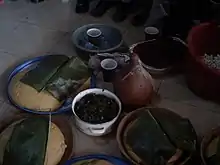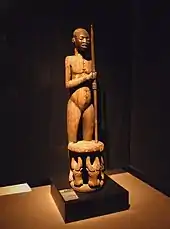Kom (peuple)
Les Kom sont une population du Cameroun vivant dans le Grassland[1]. On les considère aujourd'hui comme l'un des sous-groupes des Tikar[2].
Ethnonymie
Selon les sources et le contexte, on observe plusieurs formes : Bamekon, Bekom, Bikom, Itangikom, Kong, Nkam, Nkom[3].
Langue
Ils parlent une langue bantoue, le kom, dont le nombre de locuteurs était estimé à 233 000 en 2005[4].
Société
Contrairement à celle des Tikar, leur société est matrilinéaire[2].
Économie
Ce sont des agriculteurs et des pêcheurs[2].
Danse traditionnelle, Njang
Notes et références
- Selon Mohamad Z. Yakan, les Kom seraient également présents dans le nord-est de la République démocratique du Congo et dans d'autres pays limitrophes ((en) Mohamad Z. Yakan, « Kom », in Almanac of African Peoples & Nations, Transaction Publishers, New Brunswick, N.J., 1999, p. 432 (ISBN 9781560004332)). Cependant cette information n'est pas confirmée par d'autres sources.
- (en) « Kom », in James Stuart Olson, The Peoples of Africa: An Ethnohistorical Dictionary, Greenwood Publishing Group, 1996, p. 293 (ISBN 9780313279188)
- Source Bibliothèque du Congrès
- (en) Fiche langue
[bkm]dans la base de données linguistique Ethnologue. - (en) Christraud M. Geary, « Memorial figure of a queen mother : Kom kingdom, Cameroon, mid-19th century », in Africa: the art of a continent: 100 works of power and beauty, Guggenheim Museum Publications, New York, 1996, p. 154-155
Voir aussi
Bibliographie
- (en) Fred Ferretti, Afo-A-Kom : sacred art of Cameroon, Third Press, New York, 1975, 145 p. (ISBN 0893881341)
- (en) Walter Gam Nkwi, African modernities and mobilities : an historical ethnography of Kom, Cameroon, c. 1800-2008, Langaa Research & Publishing CIG, Mankon, Bamenda, Cameroon, 2015, 415 p. (ISBN 978-9956-762-72-9)
- (en) Paul Nchoji Nkwi, Traditional government and social change : a study of the political institutions among the Kom of the Cameroon Grassfields, University Presse, Fribourg, 1976, 233 p. (ISBN 9783827101150) (thèse)
- (en) Paul Nchoji Nkwi, « The Kom Palace : its foundation, growth and significance », in Paideuma (Wiesbaden, Allemagne), 31, 1985, p. 105-110
- (en) Tamara Northern, « The royal memorial figures from Kom », in Art of Cameroon, Smithsonian Institution, Washington, DC, 1984, p. 94-97
- (en) Jerôme Nsom, « Rites of passage in the Western Grassfields : Kom », in Patrick Mbunwe-Samba (dir.), Rites of passage and incorporation in the western grassfields of Cameroon, vol. 1, Kaberry Research Centre, Bamenda (Cameroun), 1993, p. 139-145
- Louis Perrois et Jean-Paul Notué, Rois et sculpteurs de l'ouest Cameroun : la panthère et la mygale, Éd. Karthala, Éd. de l'Orstom, Paris, 1997, 388 p. (ISBN 2-7099-1361-5)
- (en) Eugenia Shanklin, « The path to Laikom : Kom Royal court architecture », in Paideuma (Wiesbaden, Allemagne), 31, 1985, p. 111-150
- (en) Jacqueline de Vries, Catholic mission, colonial government and indigenous response in Kom (Cameroon), African Studies Centre, Leyde (Pays-Bas), 1998, 126 p. (ISBN 9054480343) (texte remanié d'une thèse)
- (de) Verena Westermann, Women's disturbances : der Anlu-Aufstand bei den Kom (Kamerun) von 1958-1960, Lit, Munster, 1992, 190 p. (ISBN 3-89473-108-7)
Articles connexes
Liens externes
- (en) Portail des Kom
- (en) Kom (Christopher D. Roy, Université de l'Iowa)
Cet article est issu de wikipedia. Text licence: CC BY-SA 4.0, Des conditions supplémentaires peuvent s’appliquer aux fichiers multimédias.







